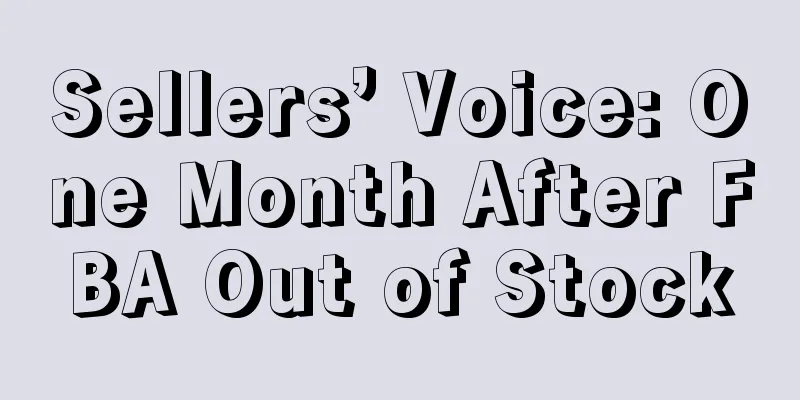Sellers’ Voice: One Month After FBA Out of Stock

|
title The small shop that opened last year started with a bumpy road I just started selling on Amazon last year, and I chose a relatively small kitchen product because I had some experience living in the United States as an exchange student during college. The families living in the local house had some demand for this product. I searched and found that not many people were making this product, so I found a manufacturer and tried to sell it on Amazon. Because the category itself is relatively small, there was no traffic in the first month after uploading. It was not until a month later that I changed the keywords and slowly started to get orders. After that, I developed several other small kitchen items. I did some reviews and in-site advertising. At that time, FBA could get about 20 orders a day, and the monthly sales were less than 20,000. After all the deductions, I didn't make much, but working on my own gives me a lot of freedom. I was planning to develop other products this year to expand my business, but then I encountered the natural disaster of the epidemic at the beginning of the year. title Demand surged at the beginning of the year, and product sales soared Before the Chinese New Year, I wanted to stay at home for a few more days, so I replenished more goods to the warehouse. Unexpectedly, the national quarantine came and everyone spent a long Spring Festival at home. The supply factory did not resume work until the end of March, and the shipment was very slow. Not to mention that Amazon also stopped receiving goods in March because kitchen utensils are not necessities and there was no way to replenish the warehouse. At this time, there was still some inventory left in FBA, and I thought I could barely hold out until restocking was allowed, but something ridiculous happened. The United States began to strictly enforce the stay-at-home order, and the demand for my kitchen products suddenly increased. I had originally expected to hold out until the end of April, but the inventory bottomed out in a few days, and some hot-selling listings were already out of stock. At this time, I already had a batch of products in hand, but Amazon was slow to restock, so I could only sell them by myself and send them by express delivery when an order came in. Although FBA was out of stock, my self-delivery orders were actually more than last year's year-end peak season, with about 50 orders per day, almost more than doubled. There were more orders, but basically no profit. The sellers who had shipped their own goods during that period should have experienced this deeply. At that time, the express logistics prices were soaring, and it was not an exaggeration to say that the prices changed every day. The profits of the self-delivery sellers were almost all used to pay for the logistics fees, and some even suffered a small loss. In this way, the self-delivery sellers survived until mid-April when Amazon began to gradually allow for replenishment. After I found out that I could restock, I immediately restocked a batch of goods according to the online order, and hurriedly found a freight forwarder to ship the goods. Unexpectedly, this wave of restocking coincided with the time when flights were suspended and all major logistics companies were out of stock. The timeliness of air delivery was dragged to a fast ship, and it took about a month to enter the warehouse and put on the shelves. During this period, I had to order another batch of goods for distribution. The pressure of stocking increased sharply, and because the stock was out of stock for too long, the orders began to decrease day by day. During that time, I had no appetite and could only stare at the freight forwarder to urge. Finally, this wave of goods was put on the shelves in mid-May, but the peak of sales had passed. Orders and rankings fell back a lot, and it was difficult to pull them up no matter how much activities and advertisements were held. I could only plan to have another explosion in the peak season in the second half of the year. After the goods arrived, I started to develop new products for the peak season, and made a few home kitchen products to slowly cultivate them. Unexpectedly, I encountered the second explosion again. title Unfortunately, I encountered a second liquidation. After the old product inventory was transferred to FBA in May, I was finally able to focus on developing new products. I also tried self-delivery first. Thanks to the increase in Amazon traffic after the epidemic, two products were sold in less than a week after uploading. The average order value of this product is relatively low, and I would lose a lot if I did self-delivery. So I quickly stocked up some products and sent them to the warehouse in early June, and this wave of express delivery collided with the wave of warehouse explosions in late June and early July. In mid-June, there was a rumor among sellers that Amazon warehouses were going to burst, and goods were piled up at the port with no one to pick them up. I felt something was wrong at that time, and after my goods arrived at the port, I checked with the freight forwarder every day to confirm the delivery status, but every time I asked, the answer was the same - "I can't make an appointment to pick up now, Amazon doesn't have anyone." This delay lasted for more than a week, and it was almost July before the logistics started to move. At this time, the news of warehouse explosion was all over the place, such as "UPS and Amazon stopped cooperating", "Federal Reserve and Amazon are at odds, deliberately not picking up/delivering each other to cause each other's warehouse explosion", etc. Until Amazon announced the restriction on delivery, my batch of goods was not put on the shelves. It was useless to take the warehouse receipt and Amazon to urge the shelves. The customer service could not solve the problem at all. Now I can only wait. Fortunately, this batch of goods is the first batch of new products, and the quantity shipped is not large, so the delayed warehousing has little impact on my sales. However, these two rounds of shipping restrictions and warehouse explosions really affect my mentality. First, the out-of-stock situation caused the order volume to be halved, and then the new product was delayed for a month. Now that the epidemic in the United States has returned, I advise everyone to restock as soon as possible. Don’t think that one or two months is enough and you can wait to restock, and extend the estimated time for restocking by double. Conclusion of the Little Clone: The current epidemic has caused various emergencies in Amazon warehouses, which will lead to delays in warehouse replenishment to varying degrees, and now the number of replenishment items is limited. Like this seller, I also suggest that everyone extend the estimated arrival time and make adequate inventory preparations. PS. When replenishing stock, you must also pay attention to your IPI. If it is less than 500, your storage space will be restricted. In this case, you must calculate the replenishment quantity to avoid excessive storage fees. Some sellers are already worried about next month’s IPI performance. After being restricted in inventory space, the excess storage fees are really expensive. |
<<: Amazon releases new countermeasures! Will take effect at the end of the year
>>: Amazon Q2 sales are out! This category has reversed
Recommend
It’s too much! A large number of sellers’ new product listings are hidden by Amazon!
Normal, once there is data abnormality, such as s...
Cross-border industry is good! China-US tariffs usher in a turnaround
Recently, China and the United States held the th...
Focusing on vertical categories, Chongqing has developed a cross-border e-commerce giant
Online sales of auto and motorcycle parts are ver...
What is Oceanpayment? Oceanpayment Review
Oceanpayment (Qianhai) was founded in May 2014. It...
Shipping costs are about to drop! Losses reversed in half a year
Recently, an overseas data agency released news th...
Crash! Europe, America and Japan restrict shipments! A large number of sellers' shipment plans have been cancelled...
0 1 Shipping restrictions on European and Japanes...
Twitter shareholders sued Musk and Twitter, claiming they manipulated the stock market to try to lower the acquisition price!
<span data-shimo-docs="[[20,"获悉,",&qu...
How can small vendors catch copycat sellers? 19 methods shared with you
Many sellers get a headache when talking about fo...
How to correctly fill the Amazon “review pit”?
Amazon sellers are complaining bitterly: “There i...
Amazon releases new compliance requirements! Products will be removed from shelves after June
Recently, Amazon released a new compliance policy...
The entire process of Amazon data-based product selection for Shenzhen's largest seller (with plug-in usage)
The article is limited in length, and the followi...
What is Quantify Ninja? Quantify Ninja Review
Quantify Ninja is a comprehensive operational tool...
Walmart adds InHome grocery delivery service as Walmart+ add-on service!
<span data-docs-delta="[[20,"获悉,沃尔玛今天宣布,其I...
A survey of US pet owners' purchasing trends! These products are in high demand...
<span data-shimo-docs="[[20,"获悉,根据美国宠物产品协会...



![[DNY123 Cross-border Morning News] Grab receives investment from South Korean retailer New World Group, Sea Insights releases Thailand e-commerce report](/upload/images/67e6eb330c787.webp)





